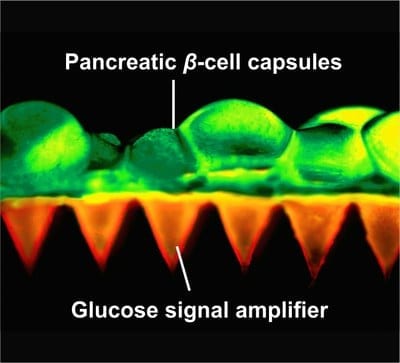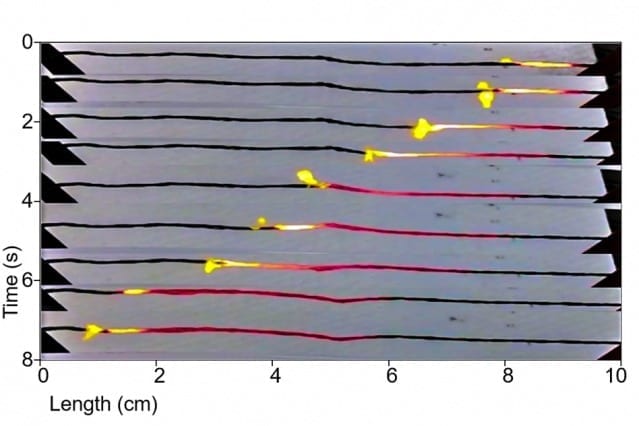
The new “smart cell patch” developed at UNC and NC State is a proof of principle to treat millions of people with type-1 and advanced type-2 diabetes.
For decades, researchers have tried to duplicate the function of beta cells, the tiny insulin-producing entities that don’t work properly in patients with diabetes. Insulin injections provide painful and often imperfect substitutes. Transplants of normal beta cells carry the risk of rejection or side effects from immunosuppressive therapies.
Now, researchers at the University of North Carolina at Chapel Hill and North Carolina State University have devised another option: a synthetic patch filled with natural beta cells that can secrete doses of insulin to control blood sugar levels on demand with no risk of inducing hypoglycemia.
The proof-of-concept builds on an innovative technology, the “smart insulin patch,” reported last year in the Proceedings of the National Academy of Sciences. Both patches are thin polymeric squares about the size of a quarter and covered in tiny needles, like a miniature bed of nails. But whereas the former approach filled these needles with manmade bubbles of insulin, this new “smart cell patch” integrates the needles with live beta cells.
Tests of this painless patch in small animal models of type-1 diabetes demonstrated that it could quickly respond to skyrocketing blood sugar levels and significantly lower them for 10 hours at a time. The results were published in Advanced Materials.
“This study provides a potential solution for the tough problem of rejection, which has long plagued studies on pancreatic cell transplants for diabetes,” said senior author Zhen Gu, PhD, assistant professor in the joint UNC/NC State department of biomedical engineering. “Plus it demonstrates that we can build a bridge between the physiological signals within the body and these therapeutic cells outside the body to keep glucose levels under control.”
Beta cells typically reside in the pancreas, where they act as the body’s natural insulin-producing factories. In healthy people, they produce, store, and release the hormone insulin to help process sugar that builds up in the bloodstream after a meal. But in people with diabetes, these cells are either damaged or unable to produce enough insulin to keep blood sugar levels under control.
Diabetes affects more than 387 million people worldwide, and that number is expected to grow to 500 million by the year 2030. Patients with type-1 and advanced type-2 diabetes must regularly monitor their blood sugar levels and inject themselves with varying amounts of insulin, a process that is painful and imprecise. Injecting the wrong amount of medication can lead to significant complications like blindness and limb amputations, or even more disastrous consequences such as diabetic comas and death.
Learn more: Scientists create painless patch of insulin-producing beta cells to control diabetes
The Latest on: Smart insulin patch
[google_news title=”” keyword=”Smart insulin patch” num_posts=”10″ blurb_length=”0″ show_thumb=”left”]
via Google News
The Latest on: Smart insulin patch
- More than 200 people with diabetes injured after software issue drained insulin pump batterieson May 8, 2024 at 12:59 pm
More than 200 people with diabetes have been injured when their insulin pumps shut down unexpectedly due to a problem with a connected mobile app, the US Food and Drug Administration said Wednesday.
- Global Smart Insulin Pens Industryon May 6, 2024 at 5:09 am
Global Smart Insulin Pens Industry is reach US$3,927.3 million in 2023, with a CAGR of 8.3%, and is anticipated to reach US$8,750.7 Mn by 2033 ...
- Ask the Doctors: Advances in Technology Help With Blood Glucose Managementon April 18, 2024 at 9:07 pm
The collected data is sent via transmitter to an app, a smart watch or a dedicated ... either via a tube, needle or patch, delivers subcutaneous insulin. The computers in these devices can be ...
- You Need to Patch Your LG Smart TV Right Nowon April 9, 2024 at 5:00 pm
Recently discovered software vulnerabilities in tens of thousands of LG smart TVs could allow cybercriminals ... LG released a patch for the security issues as part of its latest update on March ...
- Medtronic (MDT) to Expand Diabetes Care With New Buyouton May 26, 2023 at 9:10 am
Medtronic’s customers will have access to a wide range of solutions across smart multiple daily injections (MDI), tethered insulin pumps and wearable insulin patch technologies with the ...
- Lilly preps for rollout of its connected diabetes systemon March 19, 2023 at 2:08 pm
The Tempo system brings together a pre-filled insulin pen, the TempoSmart app and a recently-approved Smart Button device that stores and transfers insulin dose-related data from the pen ...
- Toward a 'Smart' Patch That Automatically Delivers Insulin When Needed (IMAGE)on October 2, 2021 at 4:59 am
Tiny, painless microneedles on a patch can deliver insulin in response to rising glucose levels. Disclaimer: AAAS and EurekAlert! are not responsible for the accuracy of news releases posted to ...
- Does Medicare Cover the Cost of Insulin Pumps?on July 30, 2020 at 5:00 pm
you wear a patch that usually contains several hundred units of insulin. The patch typically works with a smart device to monitor blood sugar levels and deliver insulin. Medicare Part D is the ...
via Bing News










